The Impact of Logo Design on Hotel Brand Image Perception
VerifiedAdded on 2021/07/28
|13
|5191
|27
Report
AI Summary
This research report investigates the impact of logo design on customer brand image perception within the hotel industry. The study, conducted in the Greater Jakarta Area, utilizes a quantitative method with questionnaires distributed to 100 respondents. The research explores the influence of logo shapes and colors, finding that both significantly impact brand perception. The shapes of the logo influence brand image perception with a percentage of 92.5%, while colors affect the brand image perception with a percentage of 92.4%. Using multiple regression analysis, the study concludes that strategic application of specific shapes and colors can enhance a hotel's brand image and market positioning. The research highlights the importance of corporate visual identity, particularly the logo, in shaping customer perceptions and building a strong brand identity. The report includes detailed analysis, model summaries, and ANOVA tables to support its findings, providing valuable insights for marketing professionals and students.
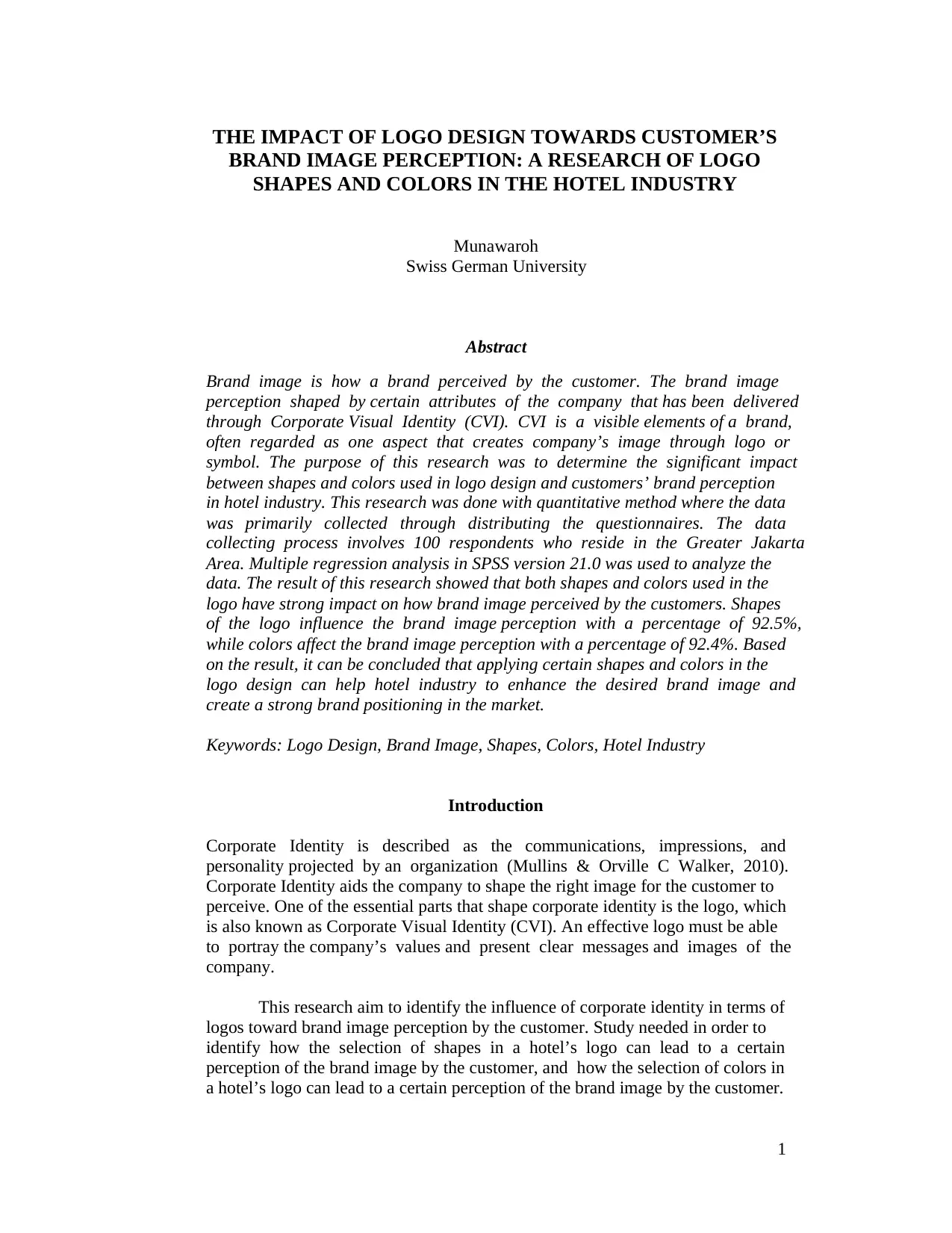
1
THE IMPACT OF LOGO DESIGN TOWARDS CUSTOMER’S
BRAND IMAGE PERCEPTION: A RESEARCH OF LOGO
SHAPES AND COLORS IN THE HOTEL INDUSTRY
Munawaroh
Swiss German University
Abstract
Brand image is how a brand perceived by the customer. The brand image
perception shaped by certain attributes of the company that has been delivered
through Corporate Visual Identity (CVI). CVI is a visible elements of a brand,
often regarded as one aspect that creates company’s image through logo or
symbol. The purpose of this research was to determine the significant impact
between shapes and colors used in logo design and customers’ brand perception
in hotel industry. This research was done with quantitative method where the data
was primarily collected through distributing the questionnaires. The data
collecting process involves 100 respondents who reside in the Greater Jakarta
Area. Multiple regression analysis in SPSS version 21.0 was used to analyze the
data. The result of this research showed that both shapes and colors used in the
logo have strong impact on how brand image perceived by the customers. Shapes
of the logo influence the brand image perception with a percentage of 92.5%,
while colors affect the brand image perception with a percentage of 92.4%. Based
on the result, it can be concluded that applying certain shapes and colors in the
logo design can help hotel industry to enhance the desired brand image and
create a strong brand positioning in the market.
Keywords: Logo Design, Brand Image, Shapes, Colors, Hotel Industry
Introduction
Corporate Identity is described as the communications, impressions, and
personality projected by an organization (Mullins & Orville C Walker, 2010).
Corporate Identity aids the company to shape the right image for the customer to
perceive. One of the essential parts that shape corporate identity is the logo, which
is also known as Corporate Visual Identity (CVI). An effective logo must be able
to portray the company’s values and present clear messages and images of the
company.
This research aim to identify the influence of corporate identity in terms of
logos toward brand image perception by the customer. Study needed in order to
identify how the selection of shapes in a hotel’s logo can lead to a certain
perception of the brand image by the customer, and how the selection of colors in
a hotel’s logo can lead to a certain perception of the brand image by the customer.
THE IMPACT OF LOGO DESIGN TOWARDS CUSTOMER’S
BRAND IMAGE PERCEPTION: A RESEARCH OF LOGO
SHAPES AND COLORS IN THE HOTEL INDUSTRY
Munawaroh
Swiss German University
Abstract
Brand image is how a brand perceived by the customer. The brand image
perception shaped by certain attributes of the company that has been delivered
through Corporate Visual Identity (CVI). CVI is a visible elements of a brand,
often regarded as one aspect that creates company’s image through logo or
symbol. The purpose of this research was to determine the significant impact
between shapes and colors used in logo design and customers’ brand perception
in hotel industry. This research was done with quantitative method where the data
was primarily collected through distributing the questionnaires. The data
collecting process involves 100 respondents who reside in the Greater Jakarta
Area. Multiple regression analysis in SPSS version 21.0 was used to analyze the
data. The result of this research showed that both shapes and colors used in the
logo have strong impact on how brand image perceived by the customers. Shapes
of the logo influence the brand image perception with a percentage of 92.5%,
while colors affect the brand image perception with a percentage of 92.4%. Based
on the result, it can be concluded that applying certain shapes and colors in the
logo design can help hotel industry to enhance the desired brand image and
create a strong brand positioning in the market.
Keywords: Logo Design, Brand Image, Shapes, Colors, Hotel Industry
Introduction
Corporate Identity is described as the communications, impressions, and
personality projected by an organization (Mullins & Orville C Walker, 2010).
Corporate Identity aids the company to shape the right image for the customer to
perceive. One of the essential parts that shape corporate identity is the logo, which
is also known as Corporate Visual Identity (CVI). An effective logo must be able
to portray the company’s values and present clear messages and images of the
company.
This research aim to identify the influence of corporate identity in terms of
logos toward brand image perception by the customer. Study needed in order to
identify how the selection of shapes in a hotel’s logo can lead to a certain
perception of the brand image by the customer, and how the selection of colors in
a hotel’s logo can lead to a certain perception of the brand image by the customer.
Paraphrase This Document
Need a fresh take? Get an instant paraphrase of this document with our AI Paraphraser
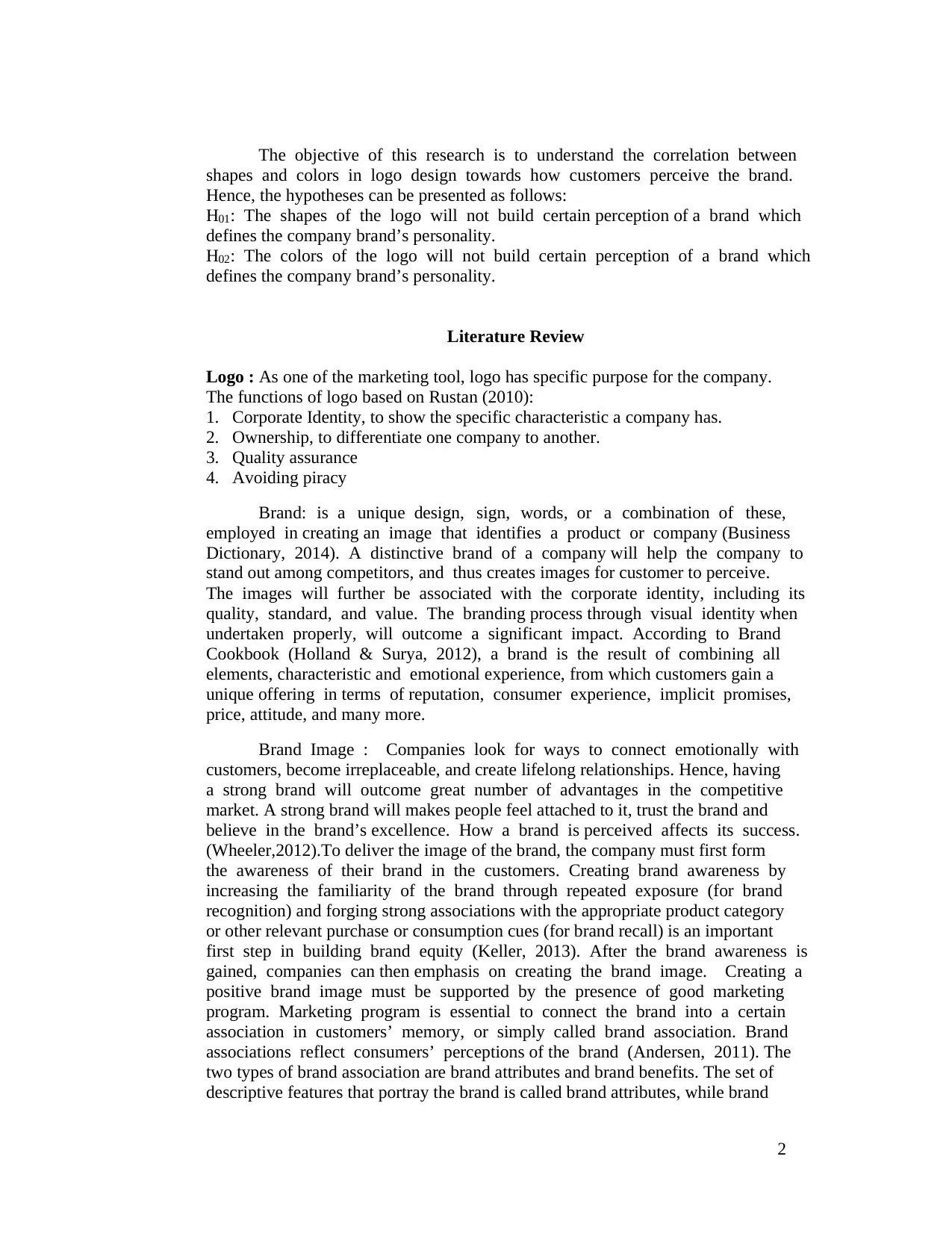
2
The objective of this research is to understand the correlation between
shapes and colors in logo design towards how customers perceive the brand.
Hence, the hypotheses can be presented as follows:
H01: The shapes of the logo will not build certain perception of a brand which
defines the company brand’s personality.
H02: The colors of the logo will not build certain perception of a brand which
defines the company brand’s personality.
Literature Review
Logo : As one of the marketing tool, logo has specific purpose for the company.
The functions of logo based on Rustan (2010):
1. Corporate Identity, to show the specific characteristic a company has.
2. Ownership, to differentiate one company to another.
3. Quality assurance
4. Avoiding piracy
Brand: is a unique design, sign, words, or a combination of these,
employed in creating an image that identifies a product or company (Business
Dictionary, 2014). A distinctive brand of a company will help the company to
stand out among competitors, and thus creates images for customer to perceive.
The images will further be associated with the corporate identity, including its
quality, standard, and value. The branding process through visual identity when
undertaken properly, will outcome a significant impact. According to Brand
Cookbook (Holland & Surya, 2012), a brand is the result of combining all
elements, characteristic and emotional experience, from which customers gain a
unique offering in terms of reputation, consumer experience, implicit promises,
price, attitude, and many more.
Brand Image : Companies look for ways to connect emotionally with
customers, become irreplaceable, and create lifelong relationships. Hence, having
a strong brand will outcome great number of advantages in the competitive
market. A strong brand will makes people feel attached to it, trust the brand and
believe in the brand’s excellence. How a brand is perceived affects its success.
(Wheeler,2012).To deliver the image of the brand, the company must first form
the awareness of their brand in the customers. Creating brand awareness by
increasing the familiarity of the brand through repeated exposure (for brand
recognition) and forging strong associations with the appropriate product category
or other relevant purchase or consumption cues (for brand recall) is an important
first step in building brand equity (Keller, 2013). After the brand awareness is
gained, companies can then emphasis on creating the brand image. Creating a
positive brand image must be supported by the presence of good marketing
program. Marketing program is essential to connect the brand into a certain
association in customers’ memory, or simply called brand association. Brand
associations reflect consumers’ perceptions of the brand (Andersen, 2011). The
two types of brand association are brand attributes and brand benefits. The set of
descriptive features that portray the brand is called brand attributes, while brand
The objective of this research is to understand the correlation between
shapes and colors in logo design towards how customers perceive the brand.
Hence, the hypotheses can be presented as follows:
H01: The shapes of the logo will not build certain perception of a brand which
defines the company brand’s personality.
H02: The colors of the logo will not build certain perception of a brand which
defines the company brand’s personality.
Literature Review
Logo : As one of the marketing tool, logo has specific purpose for the company.
The functions of logo based on Rustan (2010):
1. Corporate Identity, to show the specific characteristic a company has.
2. Ownership, to differentiate one company to another.
3. Quality assurance
4. Avoiding piracy
Brand: is a unique design, sign, words, or a combination of these,
employed in creating an image that identifies a product or company (Business
Dictionary, 2014). A distinctive brand of a company will help the company to
stand out among competitors, and thus creates images for customer to perceive.
The images will further be associated with the corporate identity, including its
quality, standard, and value. The branding process through visual identity when
undertaken properly, will outcome a significant impact. According to Brand
Cookbook (Holland & Surya, 2012), a brand is the result of combining all
elements, characteristic and emotional experience, from which customers gain a
unique offering in terms of reputation, consumer experience, implicit promises,
price, attitude, and many more.
Brand Image : Companies look for ways to connect emotionally with
customers, become irreplaceable, and create lifelong relationships. Hence, having
a strong brand will outcome great number of advantages in the competitive
market. A strong brand will makes people feel attached to it, trust the brand and
believe in the brand’s excellence. How a brand is perceived affects its success.
(Wheeler,2012).To deliver the image of the brand, the company must first form
the awareness of their brand in the customers. Creating brand awareness by
increasing the familiarity of the brand through repeated exposure (for brand
recognition) and forging strong associations with the appropriate product category
or other relevant purchase or consumption cues (for brand recall) is an important
first step in building brand equity (Keller, 2013). After the brand awareness is
gained, companies can then emphasis on creating the brand image. Creating a
positive brand image must be supported by the presence of good marketing
program. Marketing program is essential to connect the brand into a certain
association in customers’ memory, or simply called brand association. Brand
associations reflect consumers’ perceptions of the brand (Andersen, 2011). The
two types of brand association are brand attributes and brand benefits. The set of
descriptive features that portray the brand is called brand attributes, while brand
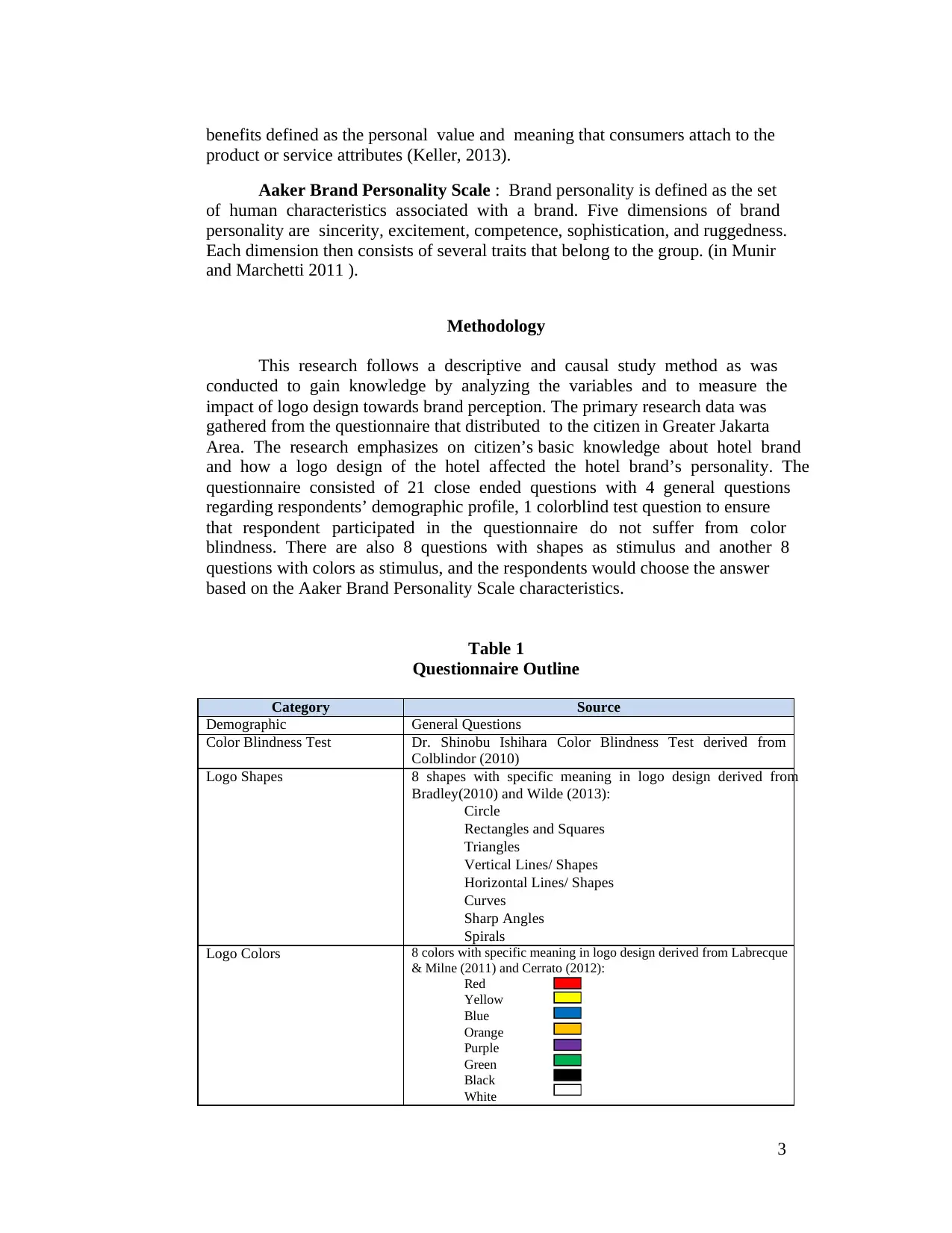
3
benefits defined as the personal value and meaning that consumers attach to the
product or service attributes (Keller, 2013).
Aaker Brand Personality Scale : Brand personality is defined as the set
of human characteristics associated with a brand. Five dimensions of brand
personality are sincerity, excitement, competence, sophistication, and ruggedness.
Each dimension then consists of several traits that belong to the group. (in Munir
and Marchetti 2011 ).
Methodology
This research follows a descriptive and causal study method as was
conducted to gain knowledge by analyzing the variables and to measure the
impact of logo design towards brand perception. The primary research data was
gathered from the questionnaire that distributed to the citizen in Greater Jakarta
Area. The research emphasizes on citizen’s basic knowledge about hotel brand
and how a logo design of the hotel affected the hotel brand’s personality. The
questionnaire consisted of 21 close ended questions with 4 general questions
regarding respondents’ demographic profile, 1 colorblind test question to ensure
that respondent participated in the questionnaire do not suffer from color
blindness. There are also 8 questions with shapes as stimulus and another 8
questions with colors as stimulus, and the respondents would choose the answer
based on the Aaker Brand Personality Scale characteristics.
Table 1
Questionnaire Outline
Category Source
Demographic General Questions
Color Blindness Test Dr. Shinobu Ishihara Color Blindness Test derived from
Colblindor (2010)
Logo Shapes 8 shapes with specific meaning in logo design derived from
Bradley(2010) and Wilde (2013):
Circle
Rectangles and Squares
Triangles
Vertical Lines/ Shapes
Horizontal Lines/ Shapes
Curves
Sharp Angles
Spirals
Logo Colors 8 colors with specific meaning in logo design derived from Labrecque
& Milne (2011) and Cerrato (2012):
Red
Yellow
Blue
Orange
Purple
Green
Black
White
benefits defined as the personal value and meaning that consumers attach to the
product or service attributes (Keller, 2013).
Aaker Brand Personality Scale : Brand personality is defined as the set
of human characteristics associated with a brand. Five dimensions of brand
personality are sincerity, excitement, competence, sophistication, and ruggedness.
Each dimension then consists of several traits that belong to the group. (in Munir
and Marchetti 2011 ).
Methodology
This research follows a descriptive and causal study method as was
conducted to gain knowledge by analyzing the variables and to measure the
impact of logo design towards brand perception. The primary research data was
gathered from the questionnaire that distributed to the citizen in Greater Jakarta
Area. The research emphasizes on citizen’s basic knowledge about hotel brand
and how a logo design of the hotel affected the hotel brand’s personality. The
questionnaire consisted of 21 close ended questions with 4 general questions
regarding respondents’ demographic profile, 1 colorblind test question to ensure
that respondent participated in the questionnaire do not suffer from color
blindness. There are also 8 questions with shapes as stimulus and another 8
questions with colors as stimulus, and the respondents would choose the answer
based on the Aaker Brand Personality Scale characteristics.
Table 1
Questionnaire Outline
Category Source
Demographic General Questions
Color Blindness Test Dr. Shinobu Ishihara Color Blindness Test derived from
Colblindor (2010)
Logo Shapes 8 shapes with specific meaning in logo design derived from
Bradley(2010) and Wilde (2013):
Circle
Rectangles and Squares
Triangles
Vertical Lines/ Shapes
Horizontal Lines/ Shapes
Curves
Sharp Angles
Spirals
Logo Colors 8 colors with specific meaning in logo design derived from Labrecque
& Milne (2011) and Cerrato (2012):
Red
Yellow
Blue
Orange
Purple
Green
Black
White
⊘ This is a preview!⊘
Do you want full access?
Subscribe today to unlock all pages.

Trusted by 1+ million students worldwide
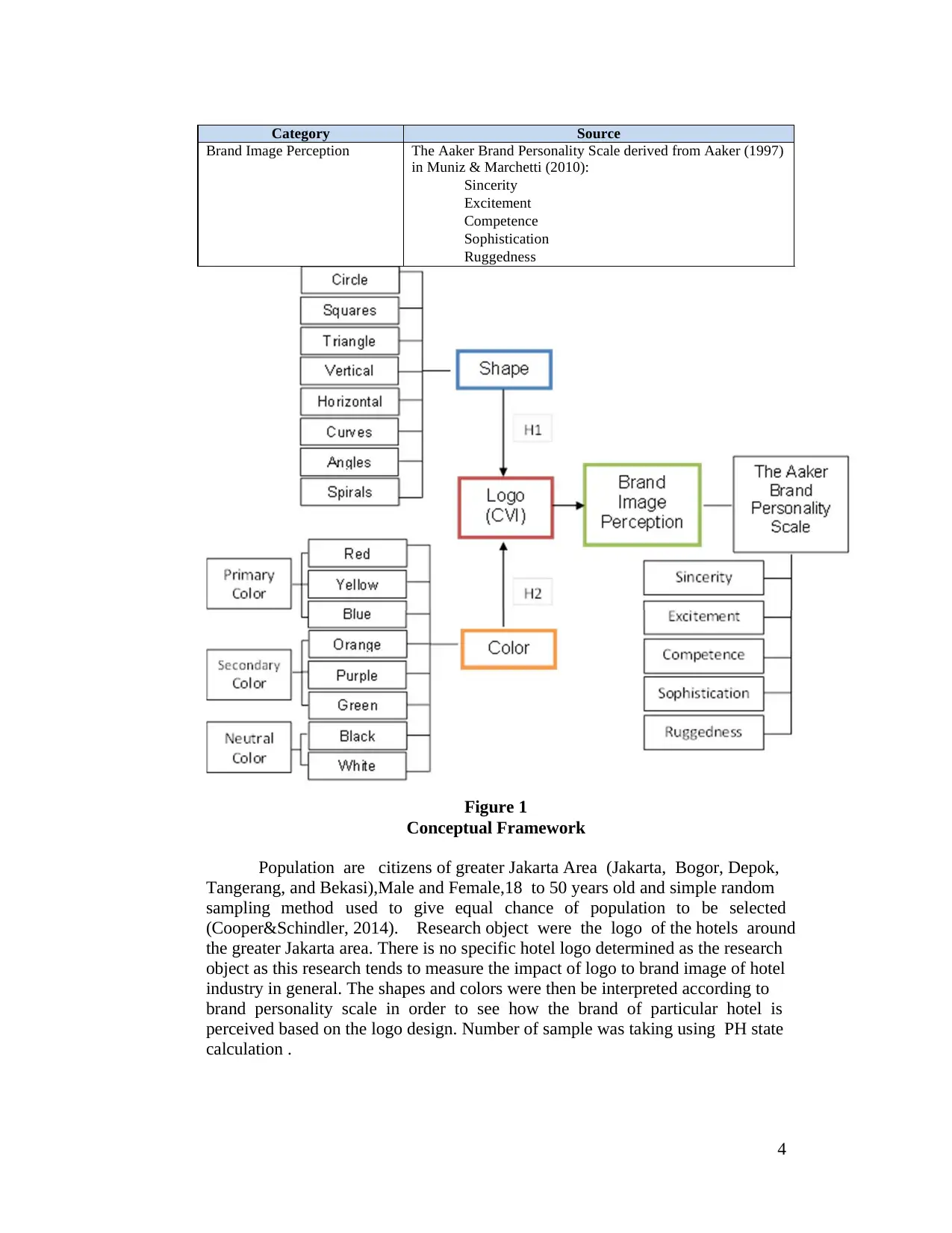
4
Category Source
Brand Image Perception The Aaker Brand Personality Scale derived from Aaker (1997)
in Muniz & Marchetti (2010):
Sincerity
Excitement
Competence
Sophistication
Ruggedness
Figure 1
Conceptual Framework
Population are citizens of greater Jakarta Area (Jakarta, Bogor, Depok,
Tangerang, and Bekasi),Male and Female,18 to 50 years old and simple random
sampling method used to give equal chance of population to be selected
(Cooper&Schindler, 2014). Research object were the logo of the hotels around
the greater Jakarta area. There is no specific hotel logo determined as the research
object as this research tends to measure the impact of logo to brand image of hotel
industry in general. The shapes and colors were then be interpreted according to
brand personality scale in order to see how the brand of particular hotel is
perceived based on the logo design. Number of sample was taking using PH state
calculation .
Category Source
Brand Image Perception The Aaker Brand Personality Scale derived from Aaker (1997)
in Muniz & Marchetti (2010):
Sincerity
Excitement
Competence
Sophistication
Ruggedness
Figure 1
Conceptual Framework
Population are citizens of greater Jakarta Area (Jakarta, Bogor, Depok,
Tangerang, and Bekasi),Male and Female,18 to 50 years old and simple random
sampling method used to give equal chance of population to be selected
(Cooper&Schindler, 2014). Research object were the logo of the hotels around
the greater Jakarta area. There is no specific hotel logo determined as the research
object as this research tends to measure the impact of logo to brand image of hotel
industry in general. The shapes and colors were then be interpreted according to
brand personality scale in order to see how the brand of particular hotel is
perceived based on the logo design. Number of sample was taking using PH state
calculation .
Paraphrase This Document
Need a fresh take? Get an instant paraphrase of this document with our AI Paraphraser
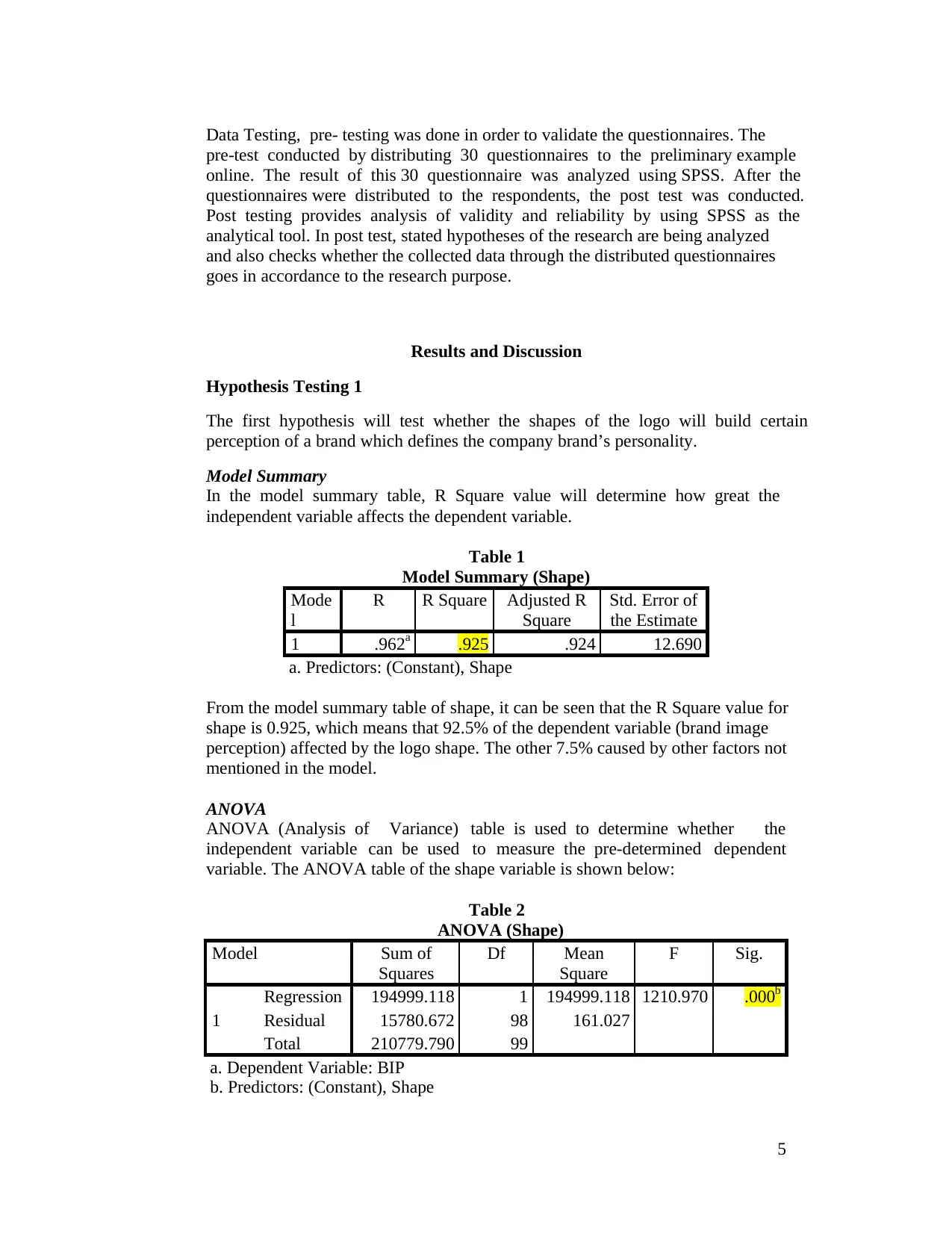
5
Data Testing, pre- testing was done in order to validate the questionnaires. The
pre-test conducted by distributing 30 questionnaires to the preliminary example
online. The result of this 30 questionnaire was analyzed using SPSS. After the
questionnaires were distributed to the respondents, the post test was conducted.
Post testing provides analysis of validity and reliability by using SPSS as the
analytical tool. In post test, stated hypotheses of the research are being analyzed
and also checks whether the collected data through the distributed questionnaires
goes in accordance to the research purpose.
Results and Discussion
Hypothesis Testing 1
The first hypothesis will test whether the shapes of the logo will build certain
perception of a brand which defines the company brand’s personality.
Model Summary
In the model summary table, R Square value will determine how great the
independent variable affects the dependent variable.
Table 1
Model Summary (Shape)
Mode
l
R R Square Adjusted R
Square
Std. Error of
the Estimate
1 .962a .925 .924 12.690
a. Predictors: (Constant), Shape
From the model summary table of shape, it can be seen that the R Square value for
shape is 0.925, which means that 92.5% of the dependent variable (brand image
perception) affected by the logo shape. The other 7.5% caused by other factors not
mentioned in the model.
ANOVA
ANOVA (Analysis of Variance) table is used to determine whether the
independent variable can be used to measure the pre-determined dependent
variable. The ANOVA table of the shape variable is shown below:
Table 2
ANOVA (Shape)
Model Sum of
Squares
Df Mean
Square
F Sig.
1
Regression 194999.118 1 194999.118 1210.970 .000b
Residual 15780.672 98 161.027
Total 210779.790 99
a. Dependent Variable: BIP
b. Predictors: (Constant), Shape
Data Testing, pre- testing was done in order to validate the questionnaires. The
pre-test conducted by distributing 30 questionnaires to the preliminary example
online. The result of this 30 questionnaire was analyzed using SPSS. After the
questionnaires were distributed to the respondents, the post test was conducted.
Post testing provides analysis of validity and reliability by using SPSS as the
analytical tool. In post test, stated hypotheses of the research are being analyzed
and also checks whether the collected data through the distributed questionnaires
goes in accordance to the research purpose.
Results and Discussion
Hypothesis Testing 1
The first hypothesis will test whether the shapes of the logo will build certain
perception of a brand which defines the company brand’s personality.
Model Summary
In the model summary table, R Square value will determine how great the
independent variable affects the dependent variable.
Table 1
Model Summary (Shape)
Mode
l
R R Square Adjusted R
Square
Std. Error of
the Estimate
1 .962a .925 .924 12.690
a. Predictors: (Constant), Shape
From the model summary table of shape, it can be seen that the R Square value for
shape is 0.925, which means that 92.5% of the dependent variable (brand image
perception) affected by the logo shape. The other 7.5% caused by other factors not
mentioned in the model.
ANOVA
ANOVA (Analysis of Variance) table is used to determine whether the
independent variable can be used to measure the pre-determined dependent
variable. The ANOVA table of the shape variable is shown below:
Table 2
ANOVA (Shape)
Model Sum of
Squares
Df Mean
Square
F Sig.
1
Regression 194999.118 1 194999.118 1210.970 .000b
Residual 15780.672 98 161.027
Total 210779.790 99
a. Dependent Variable: BIP
b. Predictors: (Constant), Shape
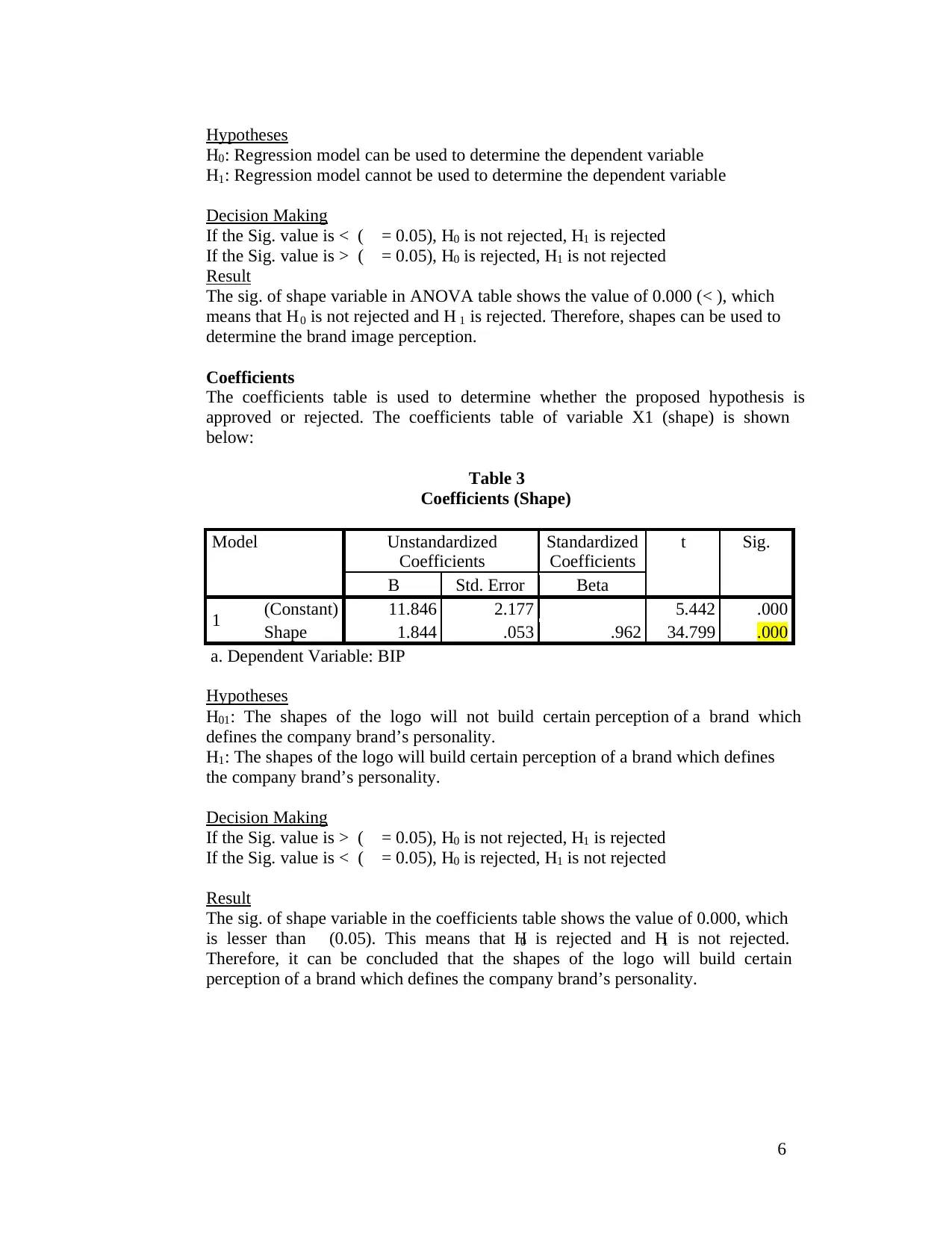
6
Hypotheses
H0: Regression model can be used to determine the dependent variable
H1: Regression model cannot be used to determine the dependent variable
Decision Making
If the Sig. value is < ( = 0.05), H0 is not rejected, H1 is rejected
If the Sig. value is > ( = 0.05), H0 is rejected, H1 is not rejected
Result
The sig. of shape variable in ANOVA table shows the value of 0.000 (< ), which
means that H0 is not rejected and H 1 is rejected. Therefore, shapes can be used to
determine the brand image perception.
Coefficients
The coefficients table is used to determine whether the proposed hypothesis is
approved or rejected. The coefficients table of variable X1 (shape) is shown
below:
Table 3
Coefficients (Shape)
Model Unstandardized
Coefficients
Standardized
Coefficients
t Sig.
B Std. Error Beta
1 (Constant) 11.846 2.177 5.442 .000
Shape 1.844 .053 .962 34.799 .000
a. Dependent Variable: BIP
Hypotheses
H01: The shapes of the logo will not build certain perception of a brand which
defines the company brand’s personality.
H1: The shapes of the logo will build certain perception of a brand which defines
the company brand’s personality.
Decision Making
If the Sig. value is > ( = 0.05), H0 is not rejected, H1 is rejected
If the Sig. value is < ( = 0.05), H0 is rejected, H1 is not rejected
Result
The sig. of shape variable in the coefficients table shows the value of 0.000, which
is lesser than (0.05). This means that H0 is rejected and H1 is not rejected.
Therefore, it can be concluded that the shapes of the logo will build certain
perception of a brand which defines the company brand’s personality.
Hypotheses
H0: Regression model can be used to determine the dependent variable
H1: Regression model cannot be used to determine the dependent variable
Decision Making
If the Sig. value is < ( = 0.05), H0 is not rejected, H1 is rejected
If the Sig. value is > ( = 0.05), H0 is rejected, H1 is not rejected
Result
The sig. of shape variable in ANOVA table shows the value of 0.000 (< ), which
means that H0 is not rejected and H 1 is rejected. Therefore, shapes can be used to
determine the brand image perception.
Coefficients
The coefficients table is used to determine whether the proposed hypothesis is
approved or rejected. The coefficients table of variable X1 (shape) is shown
below:
Table 3
Coefficients (Shape)
Model Unstandardized
Coefficients
Standardized
Coefficients
t Sig.
B Std. Error Beta
1 (Constant) 11.846 2.177 5.442 .000
Shape 1.844 .053 .962 34.799 .000
a. Dependent Variable: BIP
Hypotheses
H01: The shapes of the logo will not build certain perception of a brand which
defines the company brand’s personality.
H1: The shapes of the logo will build certain perception of a brand which defines
the company brand’s personality.
Decision Making
If the Sig. value is > ( = 0.05), H0 is not rejected, H1 is rejected
If the Sig. value is < ( = 0.05), H0 is rejected, H1 is not rejected
Result
The sig. of shape variable in the coefficients table shows the value of 0.000, which
is lesser than (0.05). This means that H0 is rejected and H1 is not rejected.
Therefore, it can be concluded that the shapes of the logo will build certain
perception of a brand which defines the company brand’s personality.
⊘ This is a preview!⊘
Do you want full access?
Subscribe today to unlock all pages.

Trusted by 1+ million students worldwide
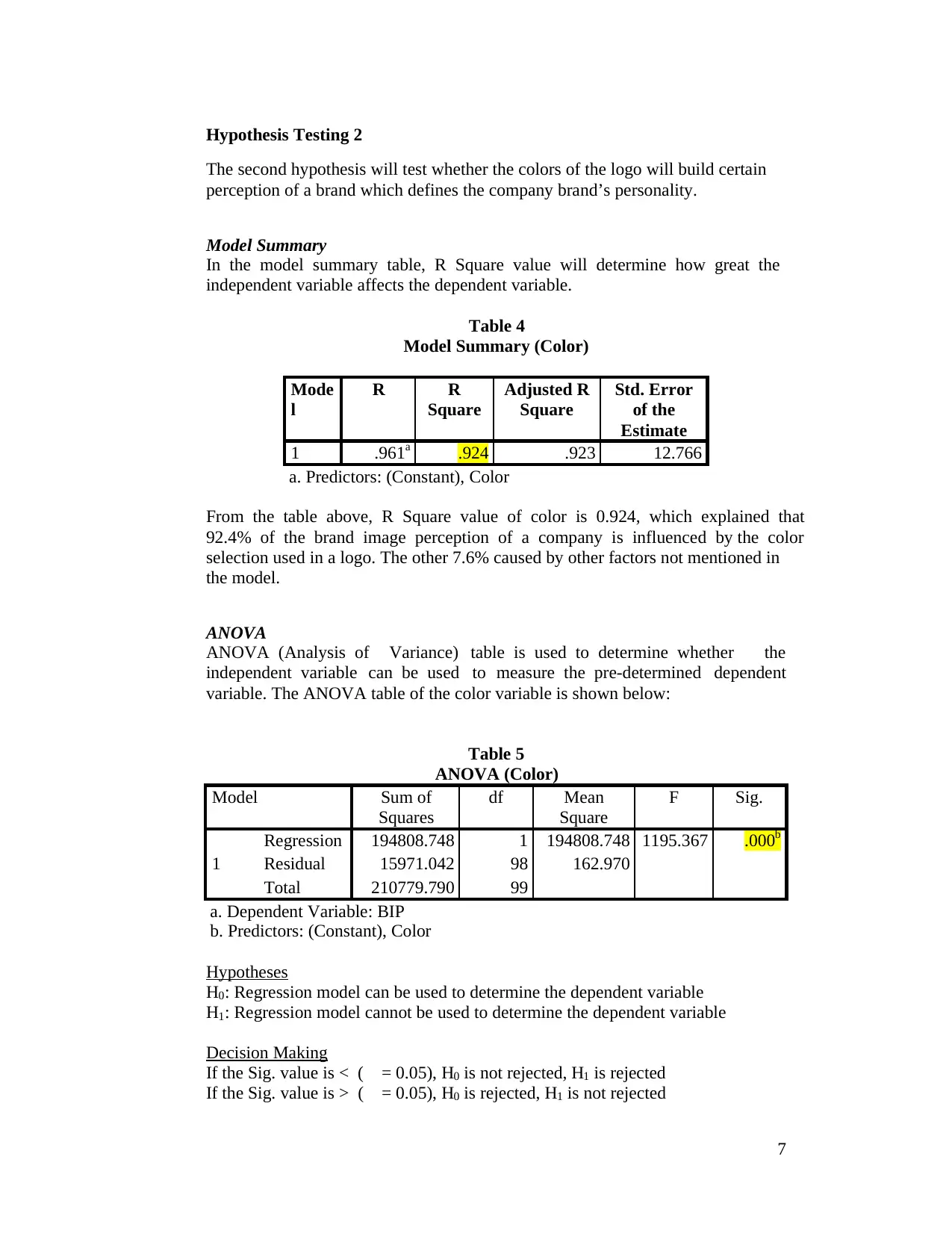
7
Hypothesis Testing 2
The second hypothesis will test whether the colors of the logo will build certain
perception of a brand which defines the company brand’s personality.
Model Summary
In the model summary table, R Square value will determine how great the
independent variable affects the dependent variable.
Table 4
Model Summary (Color)
Mode
l
R R
Square
Adjusted R
Square
Std. Error
of the
Estimate
1 .961a .924 .923 12.766
a. Predictors: (Constant), Color
From the table above, R Square value of color is 0.924, which explained that
92.4% of the brand image perception of a company is influenced by the color
selection used in a logo. The other 7.6% caused by other factors not mentioned in
the model.
ANOVA
ANOVA (Analysis of Variance) table is used to determine whether the
independent variable can be used to measure the pre-determined dependent
variable. The ANOVA table of the color variable is shown below:
Table 5
ANOVA (Color)
Model Sum of
Squares
df Mean
Square
F Sig.
1
Regression 194808.748 1 194808.748 1195.367 .000b
Residual 15971.042 98 162.970
Total 210779.790 99
a. Dependent Variable: BIP
b. Predictors: (Constant), Color
Hypotheses
H0: Regression model can be used to determine the dependent variable
H1: Regression model cannot be used to determine the dependent variable
Decision Making
If the Sig. value is < ( = 0.05), H0 is not rejected, H1 is rejected
If the Sig. value is > ( = 0.05), H0 is rejected, H1 is not rejected
Hypothesis Testing 2
The second hypothesis will test whether the colors of the logo will build certain
perception of a brand which defines the company brand’s personality.
Model Summary
In the model summary table, R Square value will determine how great the
independent variable affects the dependent variable.
Table 4
Model Summary (Color)
Mode
l
R R
Square
Adjusted R
Square
Std. Error
of the
Estimate
1 .961a .924 .923 12.766
a. Predictors: (Constant), Color
From the table above, R Square value of color is 0.924, which explained that
92.4% of the brand image perception of a company is influenced by the color
selection used in a logo. The other 7.6% caused by other factors not mentioned in
the model.
ANOVA
ANOVA (Analysis of Variance) table is used to determine whether the
independent variable can be used to measure the pre-determined dependent
variable. The ANOVA table of the color variable is shown below:
Table 5
ANOVA (Color)
Model Sum of
Squares
df Mean
Square
F Sig.
1
Regression 194808.748 1 194808.748 1195.367 .000b
Residual 15971.042 98 162.970
Total 210779.790 99
a. Dependent Variable: BIP
b. Predictors: (Constant), Color
Hypotheses
H0: Regression model can be used to determine the dependent variable
H1: Regression model cannot be used to determine the dependent variable
Decision Making
If the Sig. value is < ( = 0.05), H0 is not rejected, H1 is rejected
If the Sig. value is > ( = 0.05), H0 is rejected, H1 is not rejected
Paraphrase This Document
Need a fresh take? Get an instant paraphrase of this document with our AI Paraphraser
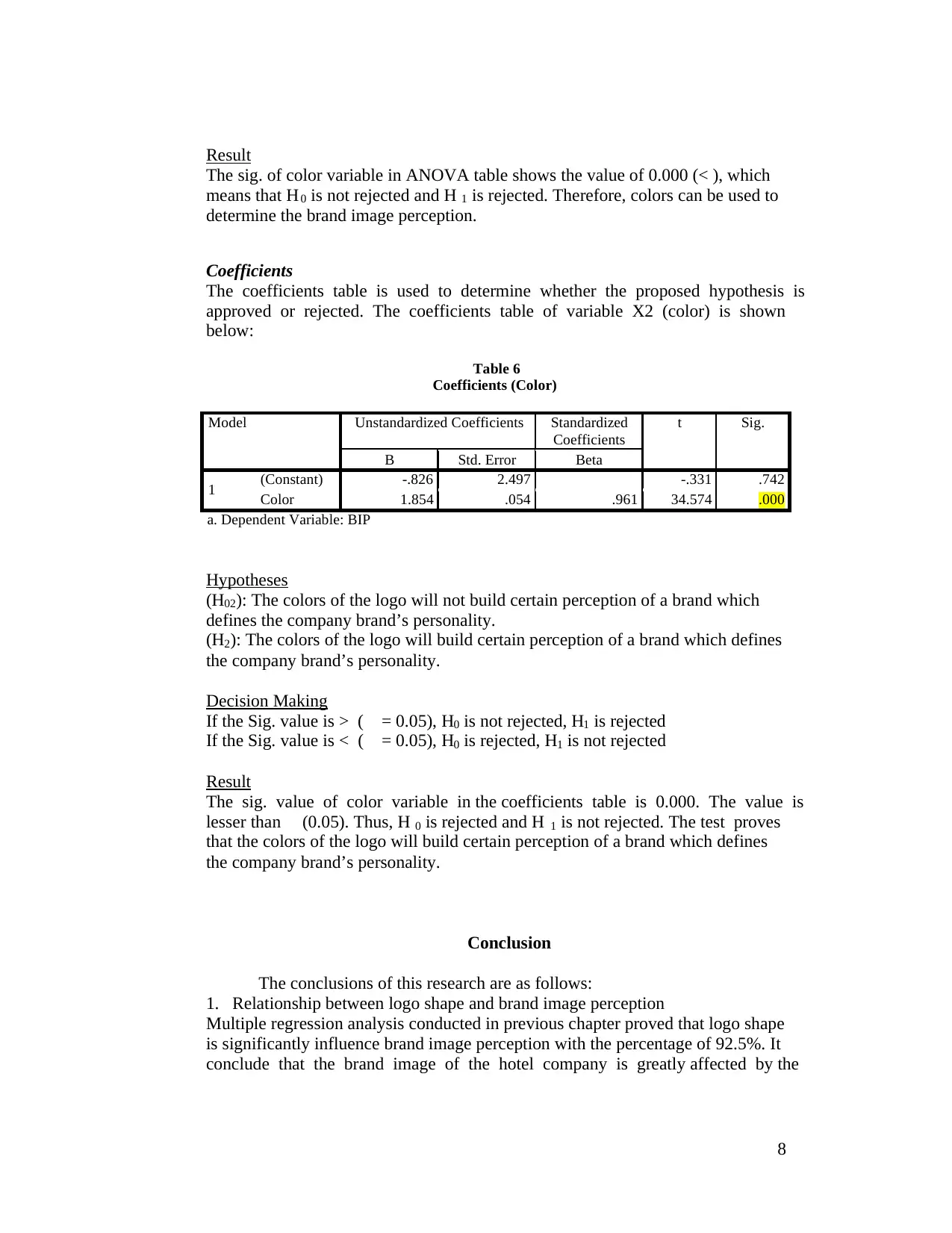
8
Result
The sig. of color variable in ANOVA table shows the value of 0.000 (< ), which
means that H0 is not rejected and H 1 is rejected. Therefore, colors can be used to
determine the brand image perception.
Coefficients
The coefficients table is used to determine whether the proposed hypothesis is
approved or rejected. The coefficients table of variable X2 (color) is shown
below:
Table 6
Coefficients (Color)
Model Unstandardized Coefficients Standardized
Coefficients
t Sig.
B Std. Error Beta
1 (Constant) -.826 2.497 -.331 .742
Color 1.854 .054 .961 34.574 .000
a. Dependent Variable: BIP
Hypotheses
(H02): The colors of the logo will not build certain perception of a brand which
defines the company brand’s personality.
(H2): The colors of the logo will build certain perception of a brand which defines
the company brand’s personality.
Decision Making
If the Sig. value is > ( = 0.05), H0 is not rejected, H1 is rejected
If the Sig. value is < ( = 0.05), H0 is rejected, H1 is not rejected
Result
The sig. value of color variable in the coefficients table is 0.000. The value is
lesser than (0.05). Thus, H 0 is rejected and H 1 is not rejected. The test proves
that the colors of the logo will build certain perception of a brand which defines
the company brand’s personality.
Conclusion
The conclusions of this research are as follows:
1. Relationship between logo shape and brand image perception
Multiple regression analysis conducted in previous chapter proved that logo shape
is significantly influence brand image perception with the percentage of 92.5%. It
conclude that the brand image of the hotel company is greatly affected by the
Result
The sig. of color variable in ANOVA table shows the value of 0.000 (< ), which
means that H0 is not rejected and H 1 is rejected. Therefore, colors can be used to
determine the brand image perception.
Coefficients
The coefficients table is used to determine whether the proposed hypothesis is
approved or rejected. The coefficients table of variable X2 (color) is shown
below:
Table 6
Coefficients (Color)
Model Unstandardized Coefficients Standardized
Coefficients
t Sig.
B Std. Error Beta
1 (Constant) -.826 2.497 -.331 .742
Color 1.854 .054 .961 34.574 .000
a. Dependent Variable: BIP
Hypotheses
(H02): The colors of the logo will not build certain perception of a brand which
defines the company brand’s personality.
(H2): The colors of the logo will build certain perception of a brand which defines
the company brand’s personality.
Decision Making
If the Sig. value is > ( = 0.05), H0 is not rejected, H1 is rejected
If the Sig. value is < ( = 0.05), H0 is rejected, H1 is not rejected
Result
The sig. value of color variable in the coefficients table is 0.000. The value is
lesser than (0.05). Thus, H 0 is rejected and H 1 is not rejected. The test proves
that the colors of the logo will build certain perception of a brand which defines
the company brand’s personality.
Conclusion
The conclusions of this research are as follows:
1. Relationship between logo shape and brand image perception
Multiple regression analysis conducted in previous chapter proved that logo shape
is significantly influence brand image perception with the percentage of 92.5%. It
conclude that the brand image of the hotel company is greatly affected by the
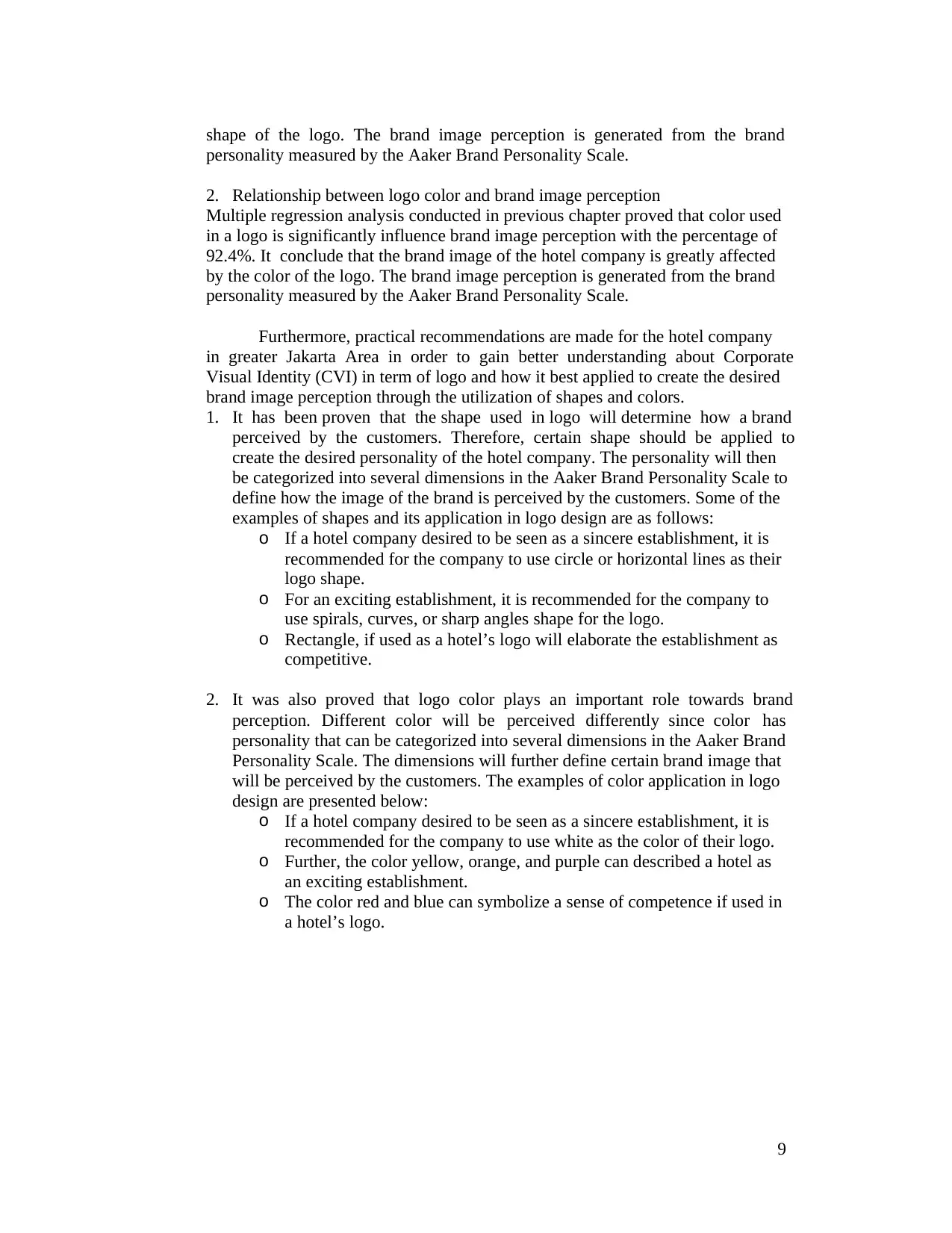
9
shape of the logo. The brand image perception is generated from the brand
personality measured by the Aaker Brand Personality Scale.
2. Relationship between logo color and brand image perception
Multiple regression analysis conducted in previous chapter proved that color used
in a logo is significantly influence brand image perception with the percentage of
92.4%. It conclude that the brand image of the hotel company is greatly affected
by the color of the logo. The brand image perception is generated from the brand
personality measured by the Aaker Brand Personality Scale.
Furthermore, practical recommendations are made for the hotel company
in greater Jakarta Area in order to gain better understanding about Corporate
Visual Identity (CVI) in term of logo and how it best applied to create the desired
brand image perception through the utilization of shapes and colors.
1. It has been proven that the shape used in logo will determine how a brand
perceived by the customers. Therefore, certain shape should be applied to
create the desired personality of the hotel company. The personality will then
be categorized into several dimensions in the Aaker Brand Personality Scale to
define how the image of the brand is perceived by the customers. Some of the
examples of shapes and its application in logo design are as follows:
o If a hotel company desired to be seen as a sincere establishment, it is
recommended for the company to use circle or horizontal lines as their
logo shape.
o For an exciting establishment, it is recommended for the company to
use spirals, curves, or sharp angles shape for the logo.
o Rectangle, if used as a hotel’s logo will elaborate the establishment as
competitive.
2. It was also proved that logo color plays an important role towards brand
perception. Different color will be perceived differently since color has
personality that can be categorized into several dimensions in the Aaker Brand
Personality Scale. The dimensions will further define certain brand image that
will be perceived by the customers. The examples of color application in logo
design are presented below:
o If a hotel company desired to be seen as a sincere establishment, it is
recommended for the company to use white as the color of their logo.
o Further, the color yellow, orange, and purple can described a hotel as
an exciting establishment.
o The color red and blue can symbolize a sense of competence if used in
a hotel’s logo.
shape of the logo. The brand image perception is generated from the brand
personality measured by the Aaker Brand Personality Scale.
2. Relationship between logo color and brand image perception
Multiple regression analysis conducted in previous chapter proved that color used
in a logo is significantly influence brand image perception with the percentage of
92.4%. It conclude that the brand image of the hotel company is greatly affected
by the color of the logo. The brand image perception is generated from the brand
personality measured by the Aaker Brand Personality Scale.
Furthermore, practical recommendations are made for the hotel company
in greater Jakarta Area in order to gain better understanding about Corporate
Visual Identity (CVI) in term of logo and how it best applied to create the desired
brand image perception through the utilization of shapes and colors.
1. It has been proven that the shape used in logo will determine how a brand
perceived by the customers. Therefore, certain shape should be applied to
create the desired personality of the hotel company. The personality will then
be categorized into several dimensions in the Aaker Brand Personality Scale to
define how the image of the brand is perceived by the customers. Some of the
examples of shapes and its application in logo design are as follows:
o If a hotel company desired to be seen as a sincere establishment, it is
recommended for the company to use circle or horizontal lines as their
logo shape.
o For an exciting establishment, it is recommended for the company to
use spirals, curves, or sharp angles shape for the logo.
o Rectangle, if used as a hotel’s logo will elaborate the establishment as
competitive.
2. It was also proved that logo color plays an important role towards brand
perception. Different color will be perceived differently since color has
personality that can be categorized into several dimensions in the Aaker Brand
Personality Scale. The dimensions will further define certain brand image that
will be perceived by the customers. The examples of color application in logo
design are presented below:
o If a hotel company desired to be seen as a sincere establishment, it is
recommended for the company to use white as the color of their logo.
o Further, the color yellow, orange, and purple can described a hotel as
an exciting establishment.
o The color red and blue can symbolize a sense of competence if used in
a hotel’s logo.
⊘ This is a preview!⊘
Do you want full access?
Subscribe today to unlock all pages.

Trusted by 1+ million students worldwide
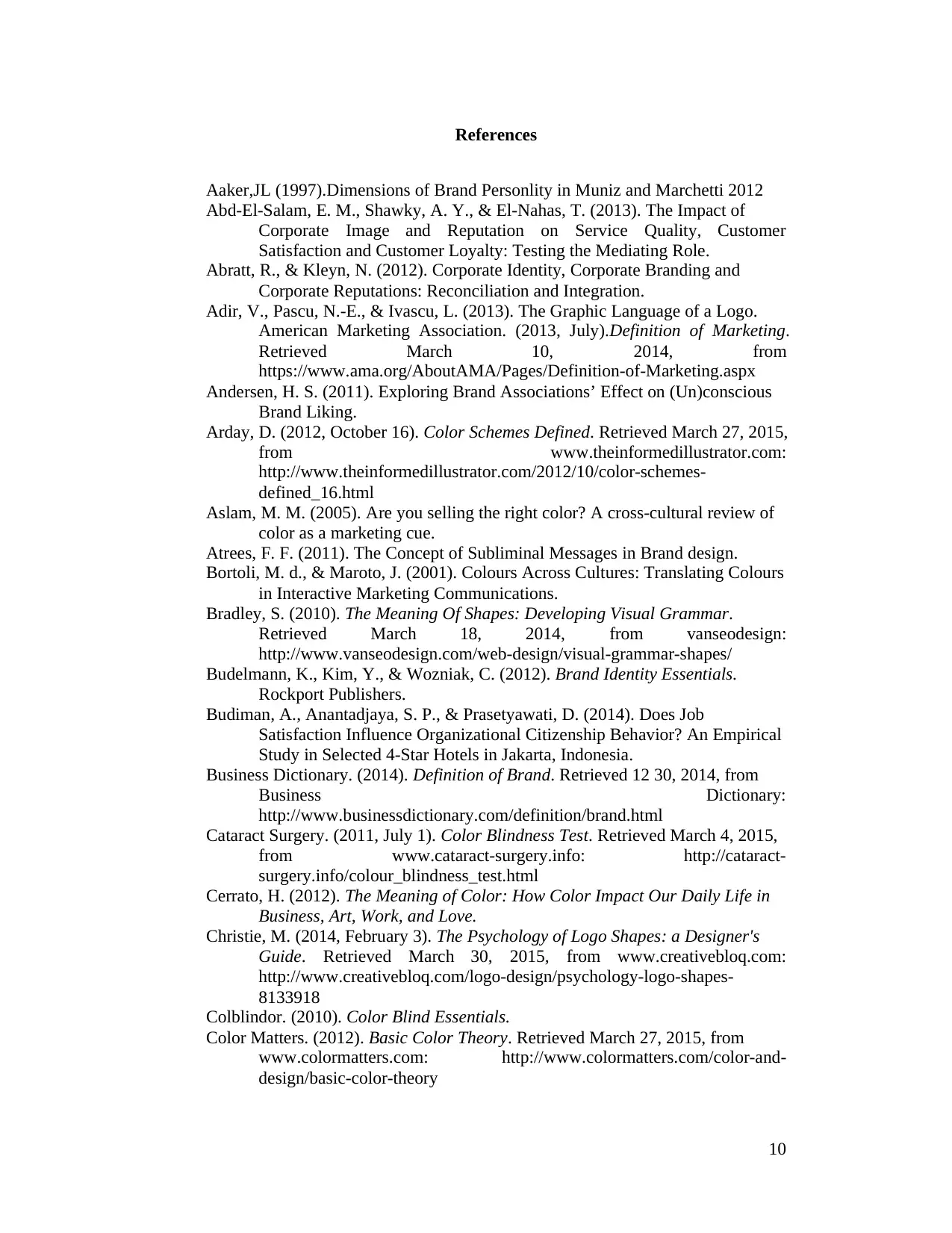
10
References
Aaker,JL (1997).Dimensions of Brand Personlity in Muniz and Marchetti 2012
Abd-El-Salam, E. M., Shawky, A. Y., & El-Nahas, T. (2013). The Impact of
Corporate Image and Reputation on Service Quality, Customer
Satisfaction and Customer Loyalty: Testing the Mediating Role.
Abratt, R., & Kleyn, N. (2012). Corporate Identity, Corporate Branding and
Corporate Reputations: Reconciliation and Integration.
Adir, V., Pascu, N.-E., & Ivascu, L. (2013). The Graphic Language of a Logo.
American Marketing Association. (2013, July).Definition of Marketing.
Retrieved March 10, 2014, from
https://www.ama.org/AboutAMA/Pages/Definition-of-Marketing.aspx
Andersen, H. S. (2011). Exploring Brand Associations’ Effect on (Un)conscious
Brand Liking.
Arday, D. (2012, October 16). Color Schemes Defined. Retrieved March 27, 2015,
from www.theinformedillustrator.com:
http://www.theinformedillustrator.com/2012/10/color-schemes-
defined_16.html
Aslam, M. M. (2005). Are you selling the right color? A cross-cultural review of
color as a marketing cue.
Atrees, F. F. (2011). The Concept of Subliminal Messages in Brand design.
Bortoli, M. d., & Maroto, J. (2001). Colours Across Cultures: Translating Colours
in Interactive Marketing Communications.
Bradley, S. (2010). The Meaning Of Shapes: Developing Visual Grammar.
Retrieved March 18, 2014, from vanseodesign:
http://www.vanseodesign.com/web-design/visual-grammar-shapes/
Budelmann, K., Kim, Y., & Wozniak, C. (2012). Brand Identity Essentials.
Rockport Publishers.
Budiman, A., Anantadjaya, S. P., & Prasetyawati, D. (2014). Does Job
Satisfaction Influence Organizational Citizenship Behavior? An Empirical
Study in Selected 4-Star Hotels in Jakarta, Indonesia.
Business Dictionary. (2014). Definition of Brand. Retrieved 12 30, 2014, from
Business Dictionary:
http://www.businessdictionary.com/definition/brand.html
Cataract Surgery. (2011, July 1). Color Blindness Test. Retrieved March 4, 2015,
from www.cataract-surgery.info: http://cataract-
surgery.info/colour_blindness_test.html
Cerrato, H. (2012). The Meaning of Color: How Color Impact Our Daily Life in
Business, Art, Work, and Love.
Christie, M. (2014, February 3). The Psychology of Logo Shapes: a Designer's
Guide. Retrieved March 30, 2015, from www.creativebloq.com:
http://www.creativebloq.com/logo-design/psychology-logo-shapes-
8133918
Colblindor. (2010). Color Blind Essentials.
Color Matters. (2012). Basic Color Theory. Retrieved March 27, 2015, from
www.colormatters.com: http://www.colormatters.com/color-and-
design/basic-color-theory
References
Aaker,JL (1997).Dimensions of Brand Personlity in Muniz and Marchetti 2012
Abd-El-Salam, E. M., Shawky, A. Y., & El-Nahas, T. (2013). The Impact of
Corporate Image and Reputation on Service Quality, Customer
Satisfaction and Customer Loyalty: Testing the Mediating Role.
Abratt, R., & Kleyn, N. (2012). Corporate Identity, Corporate Branding and
Corporate Reputations: Reconciliation and Integration.
Adir, V., Pascu, N.-E., & Ivascu, L. (2013). The Graphic Language of a Logo.
American Marketing Association. (2013, July).Definition of Marketing.
Retrieved March 10, 2014, from
https://www.ama.org/AboutAMA/Pages/Definition-of-Marketing.aspx
Andersen, H. S. (2011). Exploring Brand Associations’ Effect on (Un)conscious
Brand Liking.
Arday, D. (2012, October 16). Color Schemes Defined. Retrieved March 27, 2015,
from www.theinformedillustrator.com:
http://www.theinformedillustrator.com/2012/10/color-schemes-
defined_16.html
Aslam, M. M. (2005). Are you selling the right color? A cross-cultural review of
color as a marketing cue.
Atrees, F. F. (2011). The Concept of Subliminal Messages in Brand design.
Bortoli, M. d., & Maroto, J. (2001). Colours Across Cultures: Translating Colours
in Interactive Marketing Communications.
Bradley, S. (2010). The Meaning Of Shapes: Developing Visual Grammar.
Retrieved March 18, 2014, from vanseodesign:
http://www.vanseodesign.com/web-design/visual-grammar-shapes/
Budelmann, K., Kim, Y., & Wozniak, C. (2012). Brand Identity Essentials.
Rockport Publishers.
Budiman, A., Anantadjaya, S. P., & Prasetyawati, D. (2014). Does Job
Satisfaction Influence Organizational Citizenship Behavior? An Empirical
Study in Selected 4-Star Hotels in Jakarta, Indonesia.
Business Dictionary. (2014). Definition of Brand. Retrieved 12 30, 2014, from
Business Dictionary:
http://www.businessdictionary.com/definition/brand.html
Cataract Surgery. (2011, July 1). Color Blindness Test. Retrieved March 4, 2015,
from www.cataract-surgery.info: http://cataract-
surgery.info/colour_blindness_test.html
Cerrato, H. (2012). The Meaning of Color: How Color Impact Our Daily Life in
Business, Art, Work, and Love.
Christie, M. (2014, February 3). The Psychology of Logo Shapes: a Designer's
Guide. Retrieved March 30, 2015, from www.creativebloq.com:
http://www.creativebloq.com/logo-design/psychology-logo-shapes-
8133918
Colblindor. (2010). Color Blind Essentials.
Color Matters. (2012). Basic Color Theory. Retrieved March 27, 2015, from
www.colormatters.com: http://www.colormatters.com/color-and-
design/basic-color-theory
Paraphrase This Document
Need a fresh take? Get an instant paraphrase of this document with our AI Paraphraser
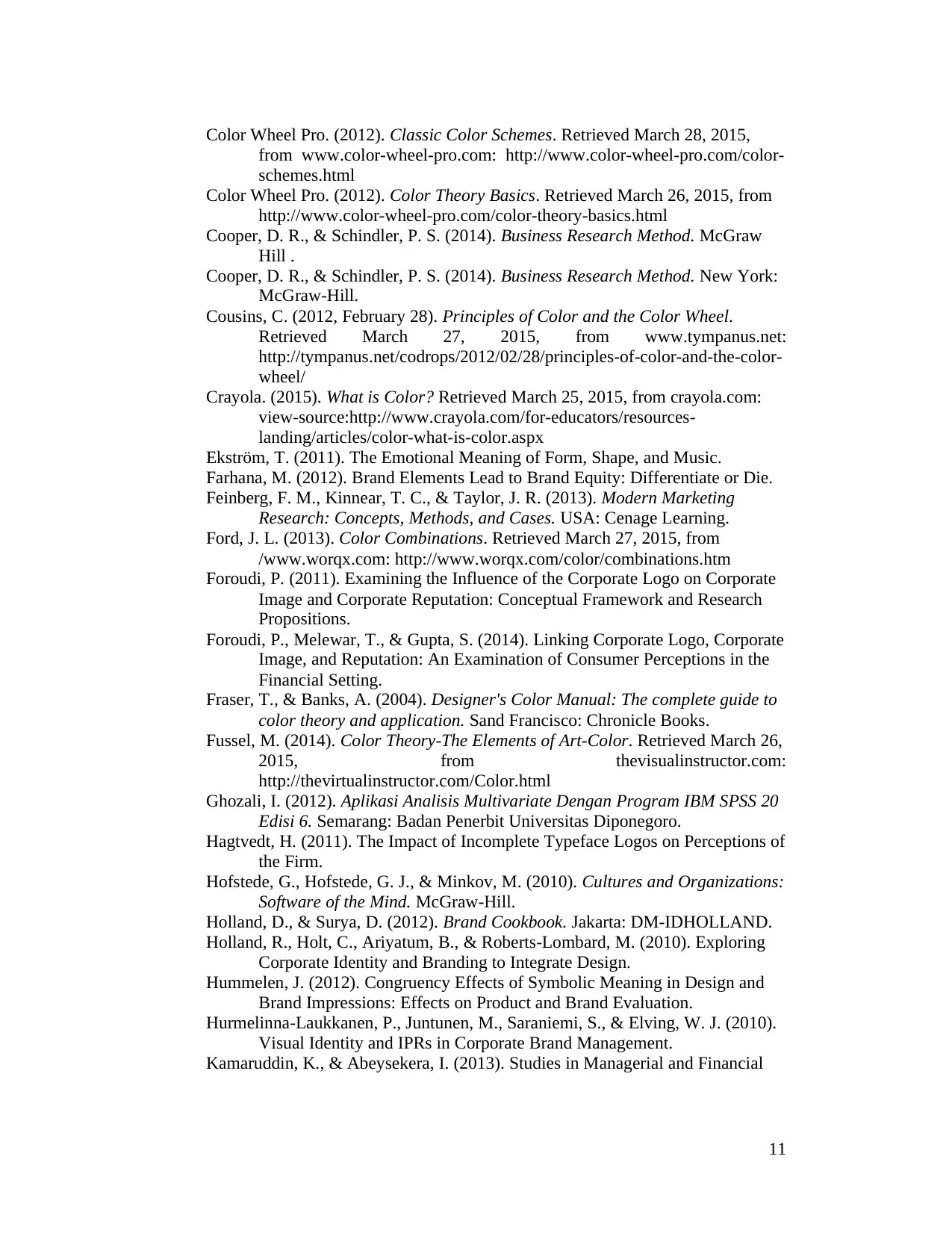
11
Color Wheel Pro. (2012). Classic Color Schemes. Retrieved March 28, 2015,
from www.color-wheel-pro.com: http://www.color-wheel-pro.com/color-
schemes.html
Color Wheel Pro. (2012). Color Theory Basics. Retrieved March 26, 2015, from
http://www.color-wheel-pro.com/color-theory-basics.html
Cooper, D. R., & Schindler, P. S. (2014). Business Research Method. McGraw
Hill .
Cooper, D. R., & Schindler, P. S. (2014). Business Research Method. New York:
McGraw-Hill.
Cousins, C. (2012, February 28). Principles of Color and the Color Wheel.
Retrieved March 27, 2015, from www.tympanus.net:
http://tympanus.net/codrops/2012/02/28/principles-of-color-and-the-color-
wheel/
Crayola. (2015). What is Color? Retrieved March 25, 2015, from crayola.com:
view-source:http://www.crayola.com/for-educators/resources-
landing/articles/color-what-is-color.aspx
Ekström, T. (2011). The Emotional Meaning of Form, Shape, and Music.
Farhana, M. (2012). Brand Elements Lead to Brand Equity: Differentiate or Die.
Feinberg, F. M., Kinnear, T. C., & Taylor, J. R. (2013). Modern Marketing
Research: Concepts, Methods, and Cases. USA: Cenage Learning.
Ford, J. L. (2013). Color Combinations. Retrieved March 27, 2015, from
/www.worqx.com: http://www.worqx.com/color/combinations.htm
Foroudi, P. (2011). Examining the Influence of the Corporate Logo on Corporate
Image and Corporate Reputation: Conceptual Framework and Research
Propositions.
Foroudi, P., Melewar, T., & Gupta, S. (2014). Linking Corporate Logo, Corporate
Image, and Reputation: An Examination of Consumer Perceptions in the
Financial Setting.
Fraser, T., & Banks, A. (2004). Designer's Color Manual: The complete guide to
color theory and application. Sand Francisco: Chronicle Books.
Fussel, M. (2014). Color Theory-The Elements of Art-Color. Retrieved March 26,
2015, from thevisualinstructor.com:
http://thevirtualinstructor.com/Color.html
Ghozali, I. (2012). Aplikasi Analisis Multivariate Dengan Program IBM SPSS 20
Edisi 6. Semarang: Badan Penerbit Universitas Diponegoro.
Hagtvedt, H. (2011). The Impact of Incomplete Typeface Logos on Perceptions of
the Firm.
Hofstede, G., Hofstede, G. J., & Minkov, M. (2010). Cultures and Organizations:
Software of the Mind. McGraw-Hill.
Holland, D., & Surya, D. (2012). Brand Cookbook. Jakarta: DM-IDHOLLAND.
Holland, R., Holt, C., Ariyatum, B., & Roberts-Lombard, M. (2010). Exploring
Corporate Identity and Branding to Integrate Design.
Hummelen, J. (2012). Congruency Effects of Symbolic Meaning in Design and
Brand Impressions: Effects on Product and Brand Evaluation.
Hurmelinna-Laukkanen, P., Juntunen, M., Saraniemi, S., & Elving, W. J. (2010).
Visual Identity and IPRs in Corporate Brand Management.
Kamaruddin, K., & Abeysekera, I. (2013). Studies in Managerial and Financial
Color Wheel Pro. (2012). Classic Color Schemes. Retrieved March 28, 2015,
from www.color-wheel-pro.com: http://www.color-wheel-pro.com/color-
schemes.html
Color Wheel Pro. (2012). Color Theory Basics. Retrieved March 26, 2015, from
http://www.color-wheel-pro.com/color-theory-basics.html
Cooper, D. R., & Schindler, P. S. (2014). Business Research Method. McGraw
Hill .
Cooper, D. R., & Schindler, P. S. (2014). Business Research Method. New York:
McGraw-Hill.
Cousins, C. (2012, February 28). Principles of Color and the Color Wheel.
Retrieved March 27, 2015, from www.tympanus.net:
http://tympanus.net/codrops/2012/02/28/principles-of-color-and-the-color-
wheel/
Crayola. (2015). What is Color? Retrieved March 25, 2015, from crayola.com:
view-source:http://www.crayola.com/for-educators/resources-
landing/articles/color-what-is-color.aspx
Ekström, T. (2011). The Emotional Meaning of Form, Shape, and Music.
Farhana, M. (2012). Brand Elements Lead to Brand Equity: Differentiate or Die.
Feinberg, F. M., Kinnear, T. C., & Taylor, J. R. (2013). Modern Marketing
Research: Concepts, Methods, and Cases. USA: Cenage Learning.
Ford, J. L. (2013). Color Combinations. Retrieved March 27, 2015, from
/www.worqx.com: http://www.worqx.com/color/combinations.htm
Foroudi, P. (2011). Examining the Influence of the Corporate Logo on Corporate
Image and Corporate Reputation: Conceptual Framework and Research
Propositions.
Foroudi, P., Melewar, T., & Gupta, S. (2014). Linking Corporate Logo, Corporate
Image, and Reputation: An Examination of Consumer Perceptions in the
Financial Setting.
Fraser, T., & Banks, A. (2004). Designer's Color Manual: The complete guide to
color theory and application. Sand Francisco: Chronicle Books.
Fussel, M. (2014). Color Theory-The Elements of Art-Color. Retrieved March 26,
2015, from thevisualinstructor.com:
http://thevirtualinstructor.com/Color.html
Ghozali, I. (2012). Aplikasi Analisis Multivariate Dengan Program IBM SPSS 20
Edisi 6. Semarang: Badan Penerbit Universitas Diponegoro.
Hagtvedt, H. (2011). The Impact of Incomplete Typeface Logos on Perceptions of
the Firm.
Hofstede, G., Hofstede, G. J., & Minkov, M. (2010). Cultures and Organizations:
Software of the Mind. McGraw-Hill.
Holland, D., & Surya, D. (2012). Brand Cookbook. Jakarta: DM-IDHOLLAND.
Holland, R., Holt, C., Ariyatum, B., & Roberts-Lombard, M. (2010). Exploring
Corporate Identity and Branding to Integrate Design.
Hummelen, J. (2012). Congruency Effects of Symbolic Meaning in Design and
Brand Impressions: Effects on Product and Brand Evaluation.
Hurmelinna-Laukkanen, P., Juntunen, M., Saraniemi, S., & Elving, W. J. (2010).
Visual Identity and IPRs in Corporate Brand Management.
Kamaruddin, K., & Abeysekera, I. (2013). Studies in Managerial and Financial
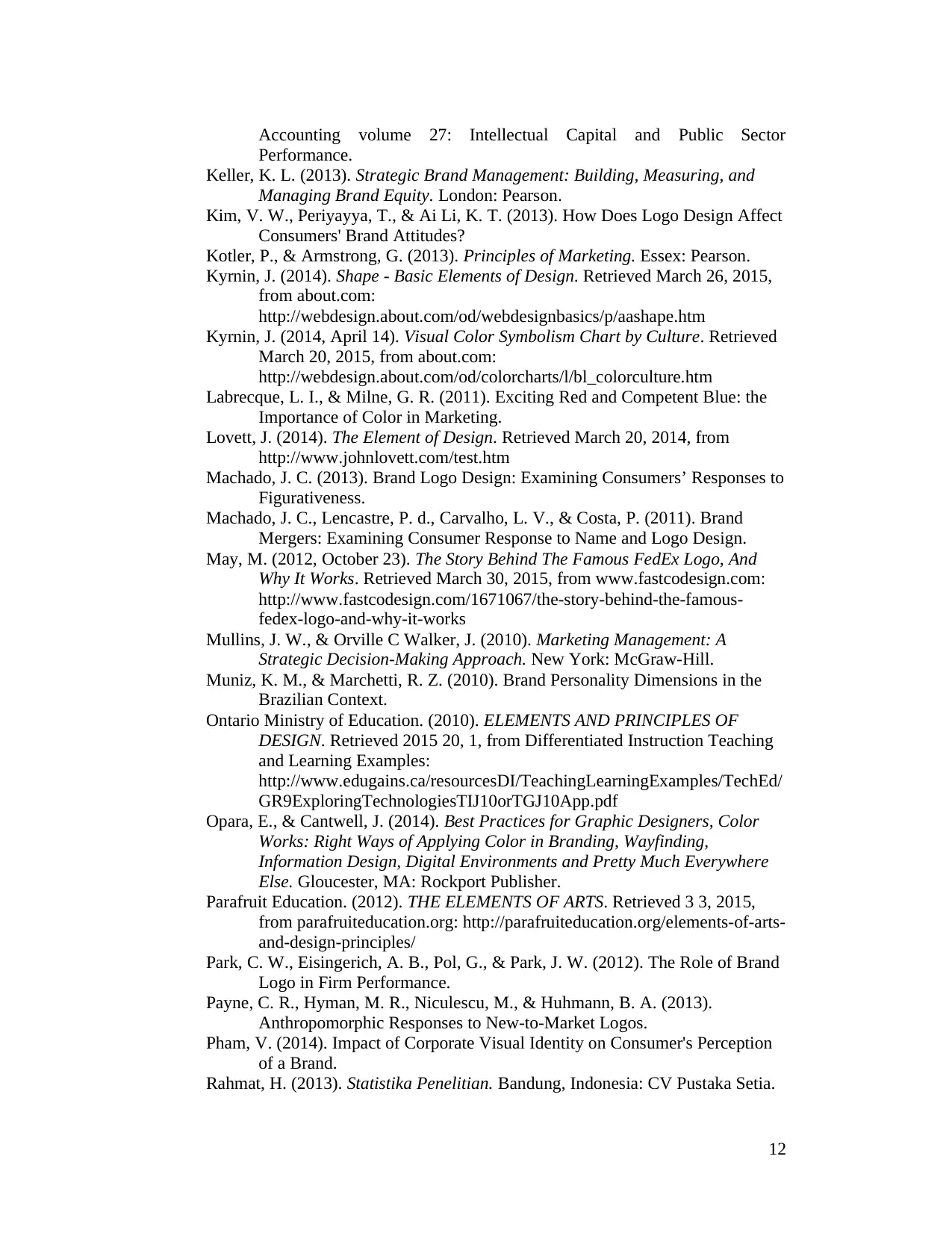
12
Accounting volume 27: Intellectual Capital and Public Sector
Performance.
Keller, K. L. (2013). Strategic Brand Management: Building, Measuring, and
Managing Brand Equity. London: Pearson.
Kim, V. W., Periyayya, T., & Ai Li, K. T. (2013). How Does Logo Design Affect
Consumers' Brand Attitudes?
Kotler, P., & Armstrong, G. (2013). Principles of Marketing. Essex: Pearson.
Kyrnin, J. (2014). Shape - Basic Elements of Design. Retrieved March 26, 2015,
from about.com:
http://webdesign.about.com/od/webdesignbasics/p/aashape.htm
Kyrnin, J. (2014, April 14). Visual Color Symbolism Chart by Culture. Retrieved
March 20, 2015, from about.com:
http://webdesign.about.com/od/colorcharts/l/bl_colorculture.htm
Labrecque, L. I., & Milne, G. R. (2011). Exciting Red and Competent Blue: the
Importance of Color in Marketing.
Lovett, J. (2014). The Element of Design. Retrieved March 20, 2014, from
http://www.johnlovett.com/test.htm
Machado, J. C. (2013). Brand Logo Design: Examining Consumers’ Responses to
Figurativeness.
Machado, J. C., Lencastre, P. d., Carvalho, L. V., & Costa, P. (2011). Brand
Mergers: Examining Consumer Response to Name and Logo Design.
May, M. (2012, October 23). The Story Behind The Famous FedEx Logo, And
Why It Works. Retrieved March 30, 2015, from www.fastcodesign.com:
http://www.fastcodesign.com/1671067/the-story-behind-the-famous-
fedex-logo-and-why-it-works
Mullins, J. W., & Orville C Walker, J. (2010). Marketing Management: A
Strategic Decision-Making Approach. New York: McGraw-Hill.
Muniz, K. M., & Marchetti, R. Z. (2010). Brand Personality Dimensions in the
Brazilian Context.
Ontario Ministry of Education. (2010). ELEMENTS AND PRINCIPLES OF
DESIGN. Retrieved 2015 20, 1, from Differentiated Instruction Teaching
and Learning Examples:
http://www.edugains.ca/resourcesDI/TeachingLearningExamples/TechEd/
GR9ExploringTechnologiesTIJ10orTGJ10App.pdf
Opara, E., & Cantwell, J. (2014). Best Practices for Graphic Designers, Color
Works: Right Ways of Applying Color in Branding, Wayfinding,
Information Design, Digital Environments and Pretty Much Everywhere
Else. Gloucester, MA: Rockport Publisher.
Parafruit Education. (2012). THE ELEMENTS OF ARTS. Retrieved 3 3, 2015,
from parafruiteducation.org: http://parafruiteducation.org/elements-of-arts-
and-design-principles/
Park, C. W., Eisingerich, A. B., Pol, G., & Park, J. W. (2012). The Role of Brand
Logo in Firm Performance.
Payne, C. R., Hyman, M. R., Niculescu, M., & Huhmann, B. A. (2013).
Anthropomorphic Responses to New-to-Market Logos.
Pham, V. (2014). Impact of Corporate Visual Identity on Consumer's Perception
of a Brand.
Rahmat, H. (2013). Statistika Penelitian. Bandung, Indonesia: CV Pustaka Setia.
Accounting volume 27: Intellectual Capital and Public Sector
Performance.
Keller, K. L. (2013). Strategic Brand Management: Building, Measuring, and
Managing Brand Equity. London: Pearson.
Kim, V. W., Periyayya, T., & Ai Li, K. T. (2013). How Does Logo Design Affect
Consumers' Brand Attitudes?
Kotler, P., & Armstrong, G. (2013). Principles of Marketing. Essex: Pearson.
Kyrnin, J. (2014). Shape - Basic Elements of Design. Retrieved March 26, 2015,
from about.com:
http://webdesign.about.com/od/webdesignbasics/p/aashape.htm
Kyrnin, J. (2014, April 14). Visual Color Symbolism Chart by Culture. Retrieved
March 20, 2015, from about.com:
http://webdesign.about.com/od/colorcharts/l/bl_colorculture.htm
Labrecque, L. I., & Milne, G. R. (2011). Exciting Red and Competent Blue: the
Importance of Color in Marketing.
Lovett, J. (2014). The Element of Design. Retrieved March 20, 2014, from
http://www.johnlovett.com/test.htm
Machado, J. C. (2013). Brand Logo Design: Examining Consumers’ Responses to
Figurativeness.
Machado, J. C., Lencastre, P. d., Carvalho, L. V., & Costa, P. (2011). Brand
Mergers: Examining Consumer Response to Name and Logo Design.
May, M. (2012, October 23). The Story Behind The Famous FedEx Logo, And
Why It Works. Retrieved March 30, 2015, from www.fastcodesign.com:
http://www.fastcodesign.com/1671067/the-story-behind-the-famous-
fedex-logo-and-why-it-works
Mullins, J. W., & Orville C Walker, J. (2010). Marketing Management: A
Strategic Decision-Making Approach. New York: McGraw-Hill.
Muniz, K. M., & Marchetti, R. Z. (2010). Brand Personality Dimensions in the
Brazilian Context.
Ontario Ministry of Education. (2010). ELEMENTS AND PRINCIPLES OF
DESIGN. Retrieved 2015 20, 1, from Differentiated Instruction Teaching
and Learning Examples:
http://www.edugains.ca/resourcesDI/TeachingLearningExamples/TechEd/
GR9ExploringTechnologiesTIJ10orTGJ10App.pdf
Opara, E., & Cantwell, J. (2014). Best Practices for Graphic Designers, Color
Works: Right Ways of Applying Color in Branding, Wayfinding,
Information Design, Digital Environments and Pretty Much Everywhere
Else. Gloucester, MA: Rockport Publisher.
Parafruit Education. (2012). THE ELEMENTS OF ARTS. Retrieved 3 3, 2015,
from parafruiteducation.org: http://parafruiteducation.org/elements-of-arts-
and-design-principles/
Park, C. W., Eisingerich, A. B., Pol, G., & Park, J. W. (2012). The Role of Brand
Logo in Firm Performance.
Payne, C. R., Hyman, M. R., Niculescu, M., & Huhmann, B. A. (2013).
Anthropomorphic Responses to New-to-Market Logos.
Pham, V. (2014). Impact of Corporate Visual Identity on Consumer's Perception
of a Brand.
Rahmat, H. (2013). Statistika Penelitian. Bandung, Indonesia: CV Pustaka Setia.
⊘ This is a preview!⊘
Do you want full access?
Subscribe today to unlock all pages.

Trusted by 1+ million students worldwide
1 out of 13
Related Documents
Your All-in-One AI-Powered Toolkit for Academic Success.
+13062052269
info@desklib.com
Available 24*7 on WhatsApp / Email
![[object Object]](/_next/static/media/star-bottom.7253800d.svg)
Unlock your academic potential
Copyright © 2020–2025 A2Z Services. All Rights Reserved. Developed and managed by ZUCOL.




